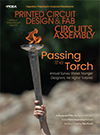News
News
Analyzing Thermal Fatigue
Published: 04 January 2007
by American Competitiveness Institute
Intermetallic growth and micro-voiding are issues for boards used in high-temp applications.

Components from Group T showed solder wetting up the leads, indicating profile issues. A majority of the solder was pulled up the lead from the base of the joint. The lack of solder under the foot contributed to a lack of solder joint strength and, hence, the failure mechanism. IPC-A-610D, 8.2.5.5 states that the target condition for maximum heel fillet height is that solder extends above the lead thickness but does not fill the upper lead bend, and that the solder does not contact the component body.1 In this case, solder was present beyond the upper lead bend and had also contacted the component. This condition is not an IPC defect by definition, but can reduce reliability.
Cross-sections of the Group T solder joint showed a solder fracture. It was deformed and ran through the Pb-rich matrix (Figure 2). These are characteristics of a cyclic fracture. Figure 3 shows the fracture was through the bulk solder and near the component intermetallic. The fracture appears to have initiated at the solder joint toe and propagated under the lead to the heel. At the component interface, intermetallic measurements of 3.5 µm indicated some growth (from a typical initial solder thickness of 1 to 1.2 µm). This indicated a high temperature application.


Microstructure observations showed severe micro-voiding in the solder’s Pb-rich regions. There was little, if any, grain growth and no grain elongation. The severe micro-voiding had enabled fracture initiation locations. The response of solder to cyclic loading under thermomechanically driven environments is complex. However, above 100°C, solder rapidly decreases in strength. The combination of application temperature (130°C) and inherent low tensile strength has severely influenced the solder microstructure and joint reliability.
Under fatigue testing at 0.0015" peak-to-peak displacements, a sample failed at 680 cycles. The crack appears to have initiated at the toe and shows some distortion (Figure 3). There is also some compression action within the crack along the intermetallic. The crack’s compression action and distortion appear to be beginning to conform and model the expected behavior. The bulk solder of the broken and opposite joint show micro-porosity and a soft distorted solder (Figure 4). Although there has been stress on the solder joint, the grain structure is not aligned. And despite temperature exposure, there is no grain enlargement.

Comparing microstructures of the original failed samples (Group T) with the fatigue samples, it was observed that the latter was beginning to approximate the damage that had occurred with the failed samples. This will inform future test fixture setup and displacement profiles that permit designs to be tested.
Further, the following materials engineering improvements are ranked in order of ease and importance.
Modification of PCB board material to higher Tg. Thermount, because of its low CTE, is expected to minimize the effects of CTE mismatch for components that are silicon (bare die) or have a large fraction of their volume (die/packaging volume ratio) as silicon. Polyimide is expected to minimize temperature effects in general because of its high Tg.
Substitution of PbSn eutectic. Solder replacement should consider the application’s high-temperature environment (Table 1). Components will need to be examined to determine if they can withstand the higher soldering temperatures.

References
- IPC-A-610D, Acceptability of Electronic Assemblies, February 2005.
The American Competitiveness Institute (aciusa.org) is a scientific research corporation dedicated to the advancement of electronics manufacturing processes and materials for the Department of Defense and industry. This column appears monthly.







